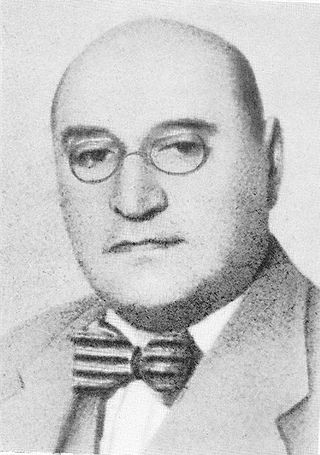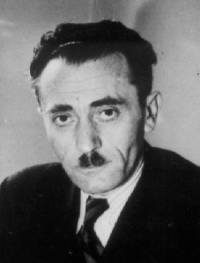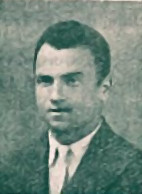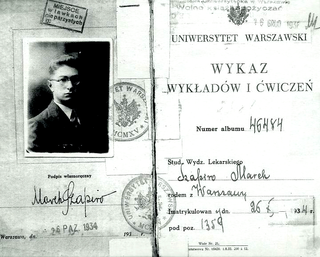Władysław Szlengel | |
|---|---|
 | |
| Born | 1912 |
| Died | 8 May 1943 (aged 28–29) Warsaw |
| Occupation(s) | poet lyricist journalist |
Władysław Szlengel (1912 – 8 May 1943) was a Polish poet, lyricist, journalist, and stage actor of Jewish decent.
Władysław Szlengel | |
|---|---|
 | |
| Born | 1912 |
| Died | 8 May 1943 (aged 28–29) Warsaw |
| Occupation(s) | poet lyricist journalist |
Władysław Szlengel (1912 – 8 May 1943) was a Polish poet, lyricist, journalist, and stage actor of Jewish decent.
Władysław Szlengel was the son of a Warsaw painter who made film posters. In 1930, Władysław Szlengel graduated from the Merchants' Assembly Trade School of the City of Warsaw.
During his school years, he first discovered his talent for rhyming. He published his texts in the student newspaper, [1] but soon established relations with a number of dailies and weeklies. [2]
Szlengel wrote only in Polish. By 1939, he was one of the most recognizable lyricists in Poland, and the author of several popular songs. He had also published satirical articles in the weekly Szpilki, and political articles in Robotnik and in the Lwów newspaper Sygnały. [2]
He took part in the 1939 defence of Warsaw. [3] Later, he moved with his wife to Białystok, at the time occupied by the Soviets. There, he worked as director of the local Miniature Theatre. [4] In 1940, he returned to Warsaw. On 16 November 1940, Waliców Street, where he lived, was made part of the Warsaw Ghetto. [2]

He became an organizer of cultural life in the district of the Ghetto. In his poetry, Szlengel described the everyday experiences and suffering of the Jews, but didn't shy away from irony. Many of his poems document the Holocaust, including "Umschlagplatz" procedures, transports to Treblinka extermination camp, and circumstances of Janusz Korczak's death. During his confinement to the Ghetto, he sought in vain to find refuge on the "Aryan" side, [5] and collaborated with Oyneg Shabbos.
He and his wife died during the Warsaw Ghetto Uprising, murdered by the Germans after being discovered in the bunker at Świętojerska Street 36, where they had a hiding place.

The Warsaw Ghetto was the largest of the Nazi ghettos during World War II and the Holocaust. It was established in November 1940 by the German authorities within the new General Government territory of occupied Poland. At its height, as many as 460,000 Jews were imprisoned there, in an area of 3.4 km2 (1.3 sq mi), with an average of 9.2 persons per room, barely subsisting on meager food rations. From the Warsaw Ghetto, Jews were deported to Nazi concentration camps and mass-killing centers. In the summer of 1942, at least 254,000 ghetto residents were sent to the Treblinka extermination camp during Großaktion Warschau under the guise of "resettlement in the East" over the course of the summer. The ghetto was demolished by the Germans in May 1943 after the Warsaw Ghetto Uprising had temporarily halted the deportations. The total death toll among the prisoners of the ghetto is estimated to be at least 300,000 killed by bullet or gas, combined with 92,000 victims of starvation and related diseases, the Warsaw Ghetto Uprising, and the casualties of the final destruction of the ghetto.
Janusz Korczak, the pen name of Henryk Goldszmit, was a Polish Jewish educator, children's author and pedagogue known as Pan Doktor or Stary Doktor. After spending many years working as a principal of an orphanage in Warsaw, he refused sanctuary repeatedly and stayed with his orphans when the entire population of the institution was sent from the Ghetto to the Treblinka extermination camp during the Grossaktion Warschau of 1942.

The Pianist is a memoir by the Polish-Jewish pianist and composer Władysław Szpilman in which he describes his life in Warsaw in occupied Poland during World War II. After being forced with his family to live in the Warsaw Ghetto, Szpilman manages to avoid deportation to the Treblinka extermination camp, and from his hiding places around the city witnesses the Warsaw Ghetto Uprising in 1943 and the Warsaw Uprising the following year. He survives in the ruined city with the help of friends and strangers, including Wilm Hosenfeld, a German army captain who admires his piano playing.

Władysław Szpilman was a Polish pianist and classical composer of Jewish descent. Szpilman is widely known as the central figure in the 2002 Roman Polanski film The Pianist, which was based on Szpilman's autobiographical account of how he survived the German occupation of Warsaw and the Holocaust.

Adam Czerniaków was a Polish engineer and senator who was head of the Warsaw Ghetto Jewish Council (Judenrat) during World War II. He committed suicide on 23 July 1942 by swallowing a cyanide pill, a day after the commencement of mass extermination of Jews known as the Grossaktion Warsaw.

Władysław Bartoszewski was a Polish politician, social activist, journalist, writer and historian. A former Auschwitz concentration camp prisoner, he was a World War II resistance fighter as part of the Polish underground and participated in the Warsaw Uprising. After the war he was persecuted and imprisoned by the communist Polish People's Republic due to his membership in the Home Army and opposition activity.

Szmul Mordko Zygielbojm was a Polish socialist politician, Bund trade-union activist, and member of the National Council of the Polish government-in-exile.

Marek Edelman was a Polish political and social activist and cardiologist. Edelman was the last surviving leader of the Warsaw Ghetto Uprising and, long before his death, was the last one to stay in Poland despite harassment by the Communist authorities.

The Pianist is a 2002 biographical war drama film produced and directed by Roman Polanski, with a script by Ronald Harwood, and starring Adrien Brody. It is based on the autobiographical book The Pianist (1946), a Holocaust memoir by the Polish-Jewish pianist and composer Władysław Szpilman, a Holocaust survivor. The film was a co-production by France, the United Kingdom, Germany and Poland.

Szymon Datner was a Polish historian, Holocaust survivor and underground operative from Białystok, best known for his studies of the Nazi war crimes and events of The Holocaust in the Białystok region. His 1946 Walka i zagłada białostockiego ghetta was one of the first studies of the Białystok Ghetto.

Ghetto benches was a form of official segregation in the seating of university students, introduced in 1935 at the Lwow Polytechnic. Rectors at other higher education institutions in the Second Polish Republic had adopted this form of segregation when the practice became conditionally legalized by 1937. Under the ghetto ławkowe system, Jewish university students were required under threat of expulsion to sit in a left-hand side section of the lecture halls reserved exclusively for them. This official policy of enforced segregation was often accompanied by acts of violence directed against Jewish students by members of the ONR.

Michał Klepfisz was a chemical engineer, activist for the Bund, and member of the Jewish Morgenstern sports organization. During World War II he belonged to the Jewish Combat Organization, fighting the Nazi German forces in Poland. He was killed in the Warsaw Ghetto Uprising and was posthumously decorated by the Polish government in exile with a Silver Cross of the Virtuti Militari.

Jan Błoński was a Polish historian, literary critic, publicist and translator. He was a leading representative of the Kraków school of literary criticism, regarded as one of the most influential critics of postwar Poland.

Radom Ghetto was a Nazi ghetto set up in March 1941 in the city of Radom during the Nazi occupation of Poland, for the purpose of persecution and exploitation of Polish Jews. It was closed off from the outside officially in April 1941. A year and a half later, the liquidation of the ghetto began in August 1942, and ended in July 1944, with approximately 30,000–32,000 victims deported aboard Holocaust trains to their deaths at the Treblinka extermination camp.

The Warsaw Ghetto boundary markers are memorial plaques and boundary lines that mark the maximum perimeter of the former ghetto established by Nazi Germany in 1940 in occupied Warsaw, Poland.

The Mińsk Mazowiecki Ghetto or the Mińsk Ghetto was a World War II ghetto set up by Nazi Germany in occupied Poland. Some 7,000 Polish Jews were imprisoned there from all neighbouring settlements for the purpose of persecution and exploitation. Two years later, beginning 21 August 1942 during the most deadly phase of the Holocaust in occupied Poland, they were rounded up – men, women and children – and deported to Treblinka extermination camp aboard Holocaust trains. In the process of Ghetto liquidation, some 1,300 Jews were summarily executed by the SS in the streets of Mińsk Mazowiecki.

Action Ghetto was the code name for the armed actions of the Polish Underground State during the Warsaw Ghetto Uprising aimed at helping the insurgents. The name was given to a series of combat actions carried out by the Home Army during the uprising between 19 April 1943 and May 16, 1943.

Jakub Lejkin was a Polish lawyer, deputy commander subordinate to the Germans at the Warsaw Ghetto. He was the administrator from May to July 1942. Lejkin played a leading role in the deportation of local Jews to extermination camps. The Germans nicknamed him “little Napoleon” and adored his brutality.

The Battle of Muranów Square was a battle between the Jewish Military Union (ŻZW) and Third Reich troops which took place during the Warsaw Ghetto Uprising on April 19–22, 1943. The fighting between the German pacification forces under Jürgen Stroop, which were destroying the ghetto, and the Jewish insurgent forces of ŻZW, under Paweł Frenkel, took place in the now non-existent Muranów Square.

Fragments of the ghetto walls in Warsaw are fragments of the walls between properties or the walls of pre-war buildings marking the border between the Warsaw Ghetto and the "Aryan" part of the city after November 16, 1940.